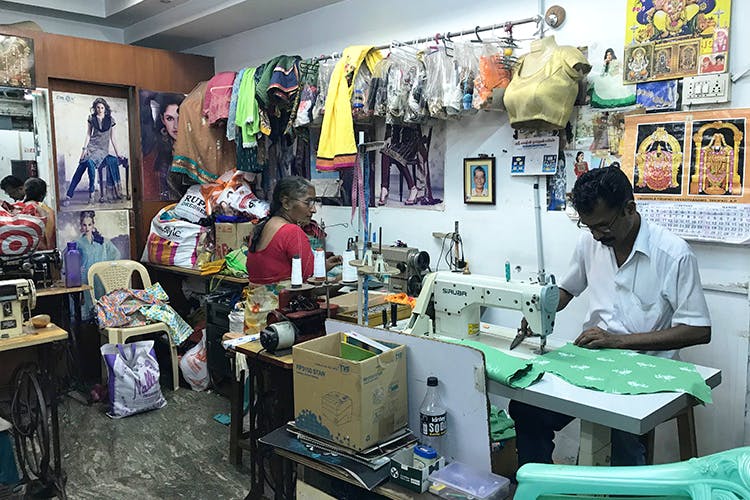Tailor Perth Specialists: Tailor-Made Solutions for Elegant Outfit
Tailor Perth Specialists: Tailor-Made Solutions for Elegant Outfit
Blog Article
Comprehending the Tailoring Process: From Material Choice to Last Suitable for the Suitable Wardrobe
The customizing process is a complex interaction of art and scientific research, beginning with the vital choice of fabric option and finishing in the precise modifications of last fittings. Each fabric type brings distinct top qualities that affect not just the visual appeal yet additionally the garment's long life and suitability for different events.
Relevance of Textile Selection
Picking the best textile is vital in the tailoring procedure, as it directly influences the comfort, durability, and total aesthetic of the last garment (tailor perth). The selection of fabric sets the structure for the garment's performance, design, and efficiency. Different fabrics have one-of-a-kind residential or commercial properties, such as breathability, weight, and stretch, which can significantly impact just how the garment drapes and fits the body
Additionally, material option influences the garment's durability and simplicity of care. Top quality textiles can stand up to deterioration, keeping their appearance and framework in time, while lower-quality materials may cause pilling or fading. Furthermore, the right textile adds to the garment's capacity to transition throughout periods and celebrations, consequently boosting convenience.
A customized item made from a suitable material not only showcases workmanship but likewise raises the wearer's self-confidence. Understanding the nuances of fabric option is extremely important for any type of customizing endeavor. It makes sure that the end product not just meets the visual desires of the client however also lines up with useful needs, thereby achieving an unified balance in between type and function in the tailored closet.
Sorts Of Fabrics and Their Uses
Understanding the various kinds of fabrics offered is vital for making notified decisions during the tailoring process. Each material possesses distinct qualities that determine its suitability for details garments and occasions.
Its flexibility enables it to be customized into whatever from tee shirts to outfits. Its all-natural flexibility assists garments keep form over time.
Silk radiates high-end and is lightweight, making it ideal for eveningwear and delicate blouses; nonetheless, it needs mindful handling due to its frailty. Linen, with its distinctive surface, is a prominent choice for warm climates, providing a airy and crisp feel, yet it wrinkles quickly, which may influence the garment's appearance.
Artificial materials, such as polyester and nylon, deal resilience and resistance to creases, making them suitable for day-to-day wear and active clothes. Understanding these textile types and their residential properties enables far better decision-making, ensuring that each customized piece not just fits well but likewise aligns with the intended purpose and celebration.
The Tailoring Strategies Explained
The art of customizing relies upon a variety of methods that transform material into well-fitted garments. Central to this process is pattern preparing, where a dressmaker creates design templates based on the client's dimensions and desired design. This preliminary step makes sure that the garment will fit the wearer properly prior to any cutting takes place.
As soon as patterns are established, cutting strategies enter into play. Accuracy is paramount as inaccuracies can cause misfitting garments. Tailors commonly use different cutting methods, such as single-layer cutting for intricate styles and multiple-layer cutting for efficiency on standard patterns.
Basting is an additional necessary method, allowing tailors to momentarily stitch textile pieces together for an initial installation. This technique uses the chance to evaluate the drape and general silhouette prior to last stitching.
Seaming techniques, consisting of flat-felled joints and French joints, boost the garment's longevity and visual allure. Tailors also employ techniques such as interfacing and padding to supply framework and form to particular areas, like shoulders and collars.
Finally, finishing techniques, consisting see post of hemming and edge finishing, make sure the garment's longevity while giving a refined appearance. With each other, these methods form the backbone of effective customizing, resulting in exquisite, custom-fit clothing.
Fitting Changes and Considerations

Trick factors to consider consist of the shoulder fit, which ought to neither droop nor limit movement, and the sleeve length, which must permit comfortable arm activity while keeping a refined appearance. Furthermore, adjustments at the waist can refine the silhouette, with options to allow out or absorb textile as needed.
The surge of pants is one more important variable; This Site it ought to rest pleasantly above the hips without triggering pain, enabling simplicity of motion. Hemming sizes for both trousers and skirts need to mirror the user's recommended design while appreciating proportions.

Maintaining Your Tailored Clothing
Proper upkeep of tailored garments is vital to protecting their fit and look gradually. To guarantee longevity, normal cleaning is vital. Constantly follow the treatment label directions, which may advise dry cleaning for delicate textiles or machine washing for even more long lasting materials. Stay clear of constant laundering, as this can put on down the textile and alter the garment's form.
Storage space is equally crucial; usage padded wall mounts for coats and layers to keep shoulder framework, and shop pants folded neatly or hung to stop creasing. Safeguard garments from direct sunshine, which can fade colors and damages fibers.
Additionally, regular assessments for minor repair services can prevent larger issues. Check for loosened buttons, tearing joints, or indications of moth damage, resolving these problems without delay to keep the garment's stability.
Lastly, consider seasonal turning. Wearing tailored pieces in small amounts allows fabrics to recover, expanding their life expectancy. By applying these upkeep techniques, you can ensure that your customized garments stay as beautiful as the day you first visit their website wore them, boosting your optimal wardrobe for years ahead.
Final Thought
The customizing process, including material selection, competent techniques, and exact suitable changes, plays a critical role in producing garments that enhance both convenience and design. Each stage adds to the overall efficiency of the end product, ensuring that apparel not just fits well however also shows specific identity. Recognizing the significance of maintenance expands the life of tailored garments, solidifying their worth in a well-curated closet. A detailed technique to tailoring culminates in a positive and sleek appearance.
Selecting the right fabric is crucial in the customizing process, as it straight affects the comfort, resilience, and total visual of the last garment. The option of material establishes the structure for the garment's design, efficiency, and performance. Various textiles possess unique buildings, such as breathability, weight, and stretch, which can substantially impact just how the garment drapes and fits the body.
The art of tailoring counts on a selection of techniques that change fabric right into well-fitted garments.The customizing process, incorporating material option, skilled strategies, and precise fitting adjustments, plays an essential duty in creating garments that enhance both convenience and design.
Report this page